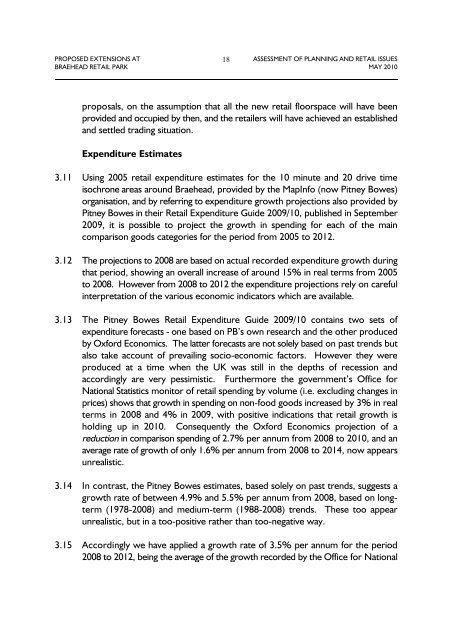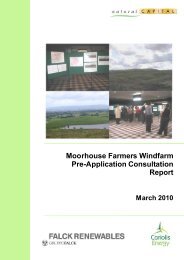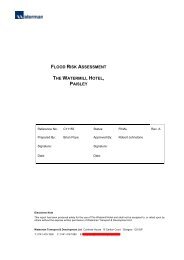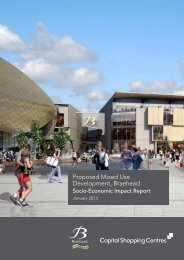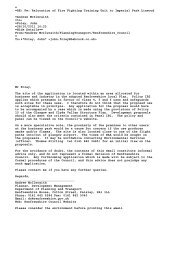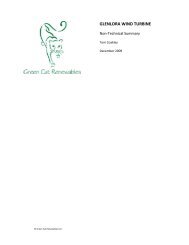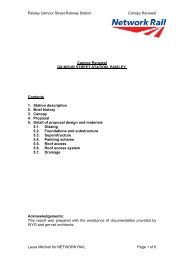Assessment of Planning and Retail Issues - Renfrewshire Council
Assessment of Planning and Retail Issues - Renfrewshire Council
Assessment of Planning and Retail Issues - Renfrewshire Council
You also want an ePaper? Increase the reach of your titles
YUMPU automatically turns print PDFs into web optimized ePapers that Google loves.
PROPOSED EXTENSIONS AT 18 ASSESSMENT OF PLANNING AND RETAIL ISSUES<br />
BRAEHEAD RETAIL PARK MAY 2010<br />
proposals, on the assumption that all the new retail floorspace will have been<br />
provided <strong>and</strong> occupied by then, <strong>and</strong> the retailers will have achieved an established<br />
<strong>and</strong> settled trading situation.<br />
Expenditure Estimates<br />
3.11 Using 2005 retail expenditure estimates for the 10 minute <strong>and</strong> 20 drive time<br />
isochrone areas around Braehead, provided by the MapInfo (now Pitney Bowes)<br />
organisation, <strong>and</strong> by referring to expenditure growth projections also provided by<br />
Pitney Bowes in their <strong>Retail</strong> Expenditure Guide 2009/10, published in September<br />
2009, it is possible to project the growth in spending for each <strong>of</strong> the main<br />
comparison goods categories for the period from 2005 to 2012.<br />
3.12 The projections to 2008 are based on actual recorded expenditure growth during<br />
that period, showing an overall increase <strong>of</strong> around 15% in real terms from 2005<br />
to 2008. However from 2008 to 2012 the expenditure projections rely on careful<br />
interpretation <strong>of</strong> the various economic indicators which are available.<br />
3.13 The Pitney Bowes <strong>Retail</strong> Expenditure Guide 2009/10 contains two sets <strong>of</strong><br />
expenditure forecasts - one based on PB’s own research <strong>and</strong> the other produced<br />
by Oxford Economics. The latter forecasts are not solely based on past trends but<br />
also take account <strong>of</strong> prevailing socio-economic factors. However they were<br />
produced at a time when the UK was still in the depths <strong>of</strong> recession <strong>and</strong><br />
accordingly are very pessimistic. Furthermore the government’s Office for<br />
National Statistics monitor <strong>of</strong> retail spending by volume (i.e. excluding changes in<br />
prices) shows that growth in spending on non-food goods increased by 3% in real<br />
terms in 2008 <strong>and</strong> 4% in 2009, with positive indications that retail growth is<br />
holding up in 2010. Consequently the Oxford Economics projection <strong>of</strong> a<br />
reduction in comparison spending <strong>of</strong> 2.7% per annum from 2008 to 2010, <strong>and</strong> an<br />
average rate <strong>of</strong> growth <strong>of</strong> only 1.6% per annum from 2008 to 2014, now appears<br />
unrealistic.<br />
3.14 In contrast, the Pitney Bowes estimates, based solely on past trends, suggests a<br />
growth rate <strong>of</strong> between 4.9% <strong>and</strong> 5.5% per annum from 2008, based on longterm<br />
(1978-2008) <strong>and</strong> medium-term (1988-2008) trends. These too appear<br />
unrealistic, but in a too-positive rather than too-negative way.<br />
3.15 Accordingly we have applied a growth rate <strong>of</strong> 3.5% per annum for the period<br />
2008 to 2012, being the average <strong>of</strong> the growth recorded by the Office for National


